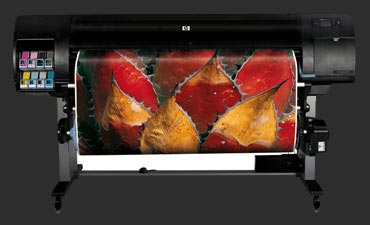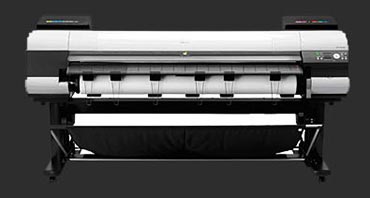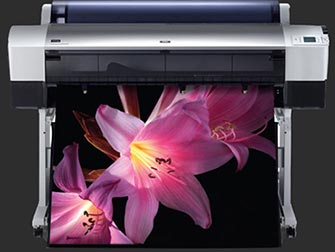Updated Comparison of HP, Canon and Epson large format fine art printers
I've had the pleasure of meeting with some of the engineers at Canon and HP that developed the latest iPF and Z series printers that are aimed at the fine art market that Epson has dominated. I have been running tests on these printers to see how they compare with each other. Since Epson has announced their new K3 with vivid magenta (K3+VM) ink printers (and I have clients with them in-house that have shared their experiences with me) I thought it would be a good time to update my comparison of these printers previously discussed in Newsletter 19.
All of these printers have ethernet and USB ports, have a large color gamut, have extremely fine dithering capable of rendering fine detail and use pigment based inks that are very archival. The differences in color gamut are not very significant. Although we are awaiting final results from the Wilhelm Institute, preliminary results suggest that the differences in print lifespan are unlikely to be significant (all 100+ years on good paper). While there are many details to discuss, I would like to provide an overview of the notable differences between these printers.
H P Z series Printers P Z series Printers
B9180 17" 8 inks US$589 (before $100 rebate)
Z2100 24" 8 inks US$2799 (before $1000 rebate)
Z2100 44" 8 inks US$5375 (before $1000 rebate)
Z3100 24" 12 inks US$3999 (before $1000 rebate)
Z3100 44" 12 inks US$5999 (before $1000 rebate)
Z6100 60" 8 inks US$17,995 (before up to $3000 trade-in)
Pros: Only printer in category with a gloss enhancer (GE) and built in spectrophotometer. HP's GE "Econo" mode puts the GE only on inked areas (instead of the entire page) for a spot varnish-like effect. The advanced black and white mode has three way split toning control. Ink and paper tracking on a per job basis. The printer's hard drive allows for centralized profile storage that works with the driver for network wide profile distribution and updating. Extremely well thought out driver allows for a very pleasurable and well informed user experience. Roll paper loads without any buttons or levers. User replaceable print heads.
Cons: Expensive. Slow when the desirable "quality" resolution setting is used. Only 24" and 44" Z3100 models use the 12 color fine art inkset. Many users cmplain about pizza wheel marks on glossy and fiber based papers. Can't use the on-board spectro to calibrate and profile other printers. HP support has been mixed (and leaning towards poor). HP has squarely denied valid user complaints about color quality and has refused to take back printers from disappointed customers.
Note: The profiles that are built with the driver an on board spectro are very good but not excellent. Users should use Application Managed Colors with externally made MonacoProfiler profiles for the best results. Even the EFI Designer Edition RIP doesn't produce spot colors quite as accurately as the driver with Application Managed Colors with MonacoProfiler profiles. All HP Z series users should be sure to update their firmware *and driver* to version 5 or newer to avoid previous problems with color quality.
InkCosts:
130ml cartridges = 50 cents per ml, $65 each, $780 for a complete set (shadesofpaper.com)
C anon PROGRAF iPF series printers anon PROGRAF iPF series printers
iPF 5000 17" 12 inks US$999 with roll feed unit and delivery (colorhq.com, shadesofpaper.com)
iPF 5000 17" 12 inks US$1399 with roll feed unit, delivery and extra set of inks (colorhq.com, shadesofpaper.com)
iPF 5100 17" 12 inks US$1495 with delivery (shadesofpaper.com)
iPF 6100 24" 12 inks US$2995 with delivery (shadesofpaper.com)
iPF 8000 44" 12 inks US$4200 with delivery and 3" spindle (shadesofpaper.com)
iPF 9000 60" 12 inks US$6000 with delivery (shadesofpaper.com)
Pros: Best-in-category print speeds and pricing. Photoshop plug-in supports true 16-bit printing up to 59 feet long. Well thought out features like no scratch paper handling, and a paper tray on the ipf5x00 that is separate from output paper handling. Improved black inks in 5100 and 6100 have the least-in-category bronzing. User replaceable print heads.
Cons: Poor support. Canon's copier-oriented support division lacks training and experience with these printers. Canon USA's website often lacks the latest downloads that Canon's other websites have.
Note: The newly announced 5100 and 6100 printers add an on-board sensor for automatic calibration (but not profiling) which will ensure printing consistency over time and after print head replacements. The 5100 and 6100 printers also use new black inks with the least-in-category bronzing and gloss differential without a gloss enhancer - black and white prints on these printers are stunning! The current pricing on the 5000 and 9000 are insanely good right now.
InkCosts:
130ml cartridges = 55 cents per ml, $72 each, $864 for a complete set (this size only for the ipf5x00) (shadesofpaper.com)
330ml cartridges = 47 cents per ml, $157 each, $1884 for a complete set (amazon.com, atlex.com)
700ml cartridges = 37 cents per ml, $260 each, $3120 for a complete set (shadesofpaper.com)
Note: most resellers offer a $250 to $500 discount on a full set of inks when purchased with a printer
 Epson Stylus Pro K3 ink with Vivid Magenta Printers Epson Stylus Pro K3 ink with Vivid Magenta Printers
3800 17" 9 inks (requires internal switching between MK and PK) US$1395
4880 17" 9 inks (requires cartridge switching between MK and PK) US$1995
7880 24" 9 inks (requires cartridge switching between MK and PK) US$2995
9880 44" 9 inks (requires cartridge switching between MK and PK) US$4995
11880 64" 9 inks US$14,995
Pros: Best-in-category support, reliability, and 3rd party RIP support.
Cons: Ink flushing and waste. All models except 3800 and 11880 require cartridge switching between photo and matte black ink. Print heads are not replaceable (but have proven to have good longevity). Poor availability of 64" rolls.
Note: The new heads have a new coating that should make them less prone to clogging. Epson now includes an ethernet port with these printers. Printing speed is increased by only ~20% on the 4800, 7880, and 9880 while the 11880 has more nozzles which doubles it's printing speed over it's smaller cousins. This makes these 17"-44" Epsons faster than the HP Z printers but not a fast as Canon's iPF printers.
InkCosts:
80ml cartridges = 62 cents per ml, $49.99 each, $449.91 for a complete set (this size only for the 3800) (atlex.com)
110ml cartridges = 45 cents per ml, $49.95 each, $449.55 for a complete set (atlex.com)
220ml cartridges = 35 cents per ml, $78 each, $702 for a complete set (shadesofpaper.com)
Read Josheph Holmes' excellent article on the new Epsons at http://www.josephholmes.com/news-epson11880.html
All prices reflect the lowest street pricing that I have found from a variety of resellers including shadesofpaper.com, atlex.com, colorhq.com and itsupplies.com. I am not affiliated with or benefit from the mention of these resellers. I simply mention the lowest prices that I have found for your convenience and reference. Let me know if you find better pricing.
The above ink costs may be deceptive because they don't factor in how much ink each printer uses to make the same print. Although I haven't yet quantified this with tests, Epsons appear to use considerably more ink than both HP and Canon to make the same 8x10 print. If this is the case, then Canon's low ink cost with low ink consumption could the the most affordable of the bunch, even though he total cost of a complete set of inks is high. While Epson's low per milliliter and complete set ink costs are low I suspect this is deceptive and the actual costs to the user to be much higher. If you can tell me how much ink is used to print my 8x10 evaluation image on what printers, papers and resolution settings I would appreciate that feedback.
HP and Canon's printers use user-replaceable thermal print heads as opposed to Epson's fixed piezoelectric print head technology. While thermal head technology has been an inconsistent performer in the past, it appears that HP and Canon have good reason to expect these latest heads to be extremely consistent over their lifetime. Extremely high volume users should however expect to replace their thermal heads more frequently than piezoelectric heads. Because the thermal heads are user replaceable and Epson's are not, this difference is probably a wash in terms of long term, high volume cost and convenience. Lower volume consumers should not have to replace print heads so this difference should be insignificant.
With these printers being so high quality and so similar in many ways it is difficult to make recommendations. Users needing reliability and familiarity without the need for both matte and photo black inks will be attracted to the latest K3+VM Epson printers. For those that don't need lots of speed but are attracted to an on board spectrophotometer and gloss enhancer the 24" and 44" HP Z series printers are the only game in town. Canon's iPF xx00 printers are attractive to those looking for an excellent value, shorter print times (and the least bronzing in the x100 models).
|